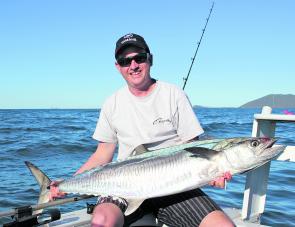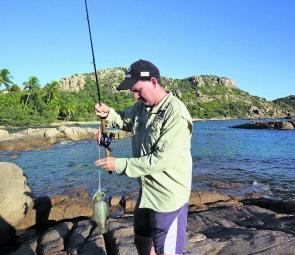Getting out of bed early to go fishing during the cold winter months is always a bit of a struggle, however there is no motivation to through on the old jumper and beanie quite like the possibility of going head-to-head with a big Spanish mackerel.
This month, there will be no better opportunity to turn this dream into a reality as the Spaniards will be running and they will be running hard. To add to this good news, these great sportfish will be on offer in inshore waters, which means you don’t need a big offshore boat to chase them. In fact, the larger fish that push the 35-40kg mark tend to be caught by inshore fishermen only 3-5km offshore this time of year, which is an exciting prospect for those with small tinnies usually suited to chasing a few scales up the creek.
Likely hots spots include Innamincka or North Head Rock and the passage between Stone and Lighthouse islands (both less than 2 km offshore). These are proven areas for big mackerel this time of year, especially if you are trolling ribbonfish. Ribbon fish or wolf herring are gun baits for Spanish mackerel and really do entice the bigger fish to get on board. I exclusively troll these baits these days, especially around these inshore spots and if there is a fish around they will almost always jump on.
The inner (4km) and outer (6km) Mackerel Patches are also excellent inshore spots for Spanish mackerel, however they are also packed with the smaller, less desirable spotted and doggie mackerel that are notorious for tail snipping ribbon fish baits. This can be a frustrating experience, as baits do take a while to rig and they aren’t cheap either! The other main problem with targeting Spanish mackerel at these spots is the men in grey suits. Big whaler sharks and tigers love mackerel more than anything else in the sea and when you have thousands of mackerel schooled up in a single spot, you tend to find the sharks are not far behind. Sharks, in particular whalers love scoffing down a ribbonfish, which also creates the problematic scenario of getting your expensive rigs back. I can tell you, battling a 7’ whaler on the line, and then trying to get your multi hook rig back out of its angry jaws is not something we do for fun.
On the brighter side, if the Spanish are not biting in this area, then there are plenty of smaller mackerel to keep you occupied. The Patches usually fish their best this time of the year, especially on those glassed out days when the fish feed in the top part of the water column. On these occasions, you can visibly see the fish feeding through the water in large numbers, which makes them excellent targets for surface and fly fishermen.
Vertical jigging is also an excellent technique and soft plastic vibes like thready busters are always a dynamite offering. The vibration created by these plastics always fires up the fish, especially when they are being a little picky.
If soft plastics are not your thing, then most metal slugs worked with as much as speed as possible either across the surface or vertical are a top option. This can draw out a reaction bite in the smaller macks and it’s top fun to watch them chase the lure all the way before finally sucking it down inches from the boat.
Offshore or further travel areas like Abbott Point, as well as Camp, Glouster and Holbourne islands are also a top spot for Spanish mackerel this time of year. These spots tend to hold the smaller schooling fish, though larger fish are not uncommon.
Last year, we had a massive run of small black marlin and sailfish on the mackerel grounds out this way and there are plenty of anglers hoping to get into a few more this year as well. The best bet when fishing these areas is to follow the bathometric lines on your GPS plotter, as the macks tend to cruise these spots looking for a feed.
Often the best bite is right on sun up so getting out there early especially before lots of boats move in will always put you in front.
Land-based anglers are also in for a treat this time of the year with plenty of squid on offer around the coral filled bays of Bowen. Hunting these tasty morsels on the top of the tide in sheltered waters is always a top option in August, as the squid tend to move into the shallow water in big numbers. This means multiple captures of squid are on offer and it’s not uncommon to catch multiple squid over consecutive casts. All the bays around Bowen hold good numbers of squid and they are also in big numbers around the islands as well.
Next month, we should see the last of the big pelagic runs as they move further south. This should see the water beginning to warm and the transition back to the excellent creek fishing for barra and jacks. September always yields pretty good fishing weather as well, so there should be plenty of opportunity to get out wide and get among some fish.
Reads: 1685
Spanish mackerel will be the main target in August and fish like this are available for the anglers who brave the cold weather.

Squid are a top land based option in August around Bowen’s coral filled bays.

Spotted mackerel will be prolific over August and soft vibes are a top way to get them to bite




